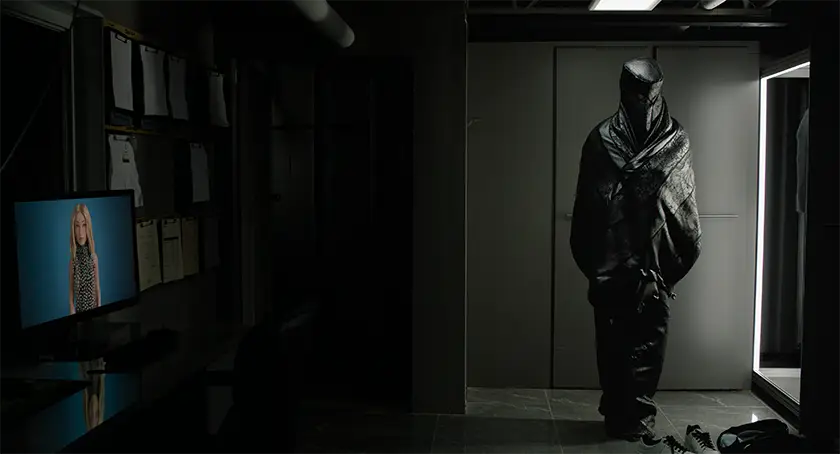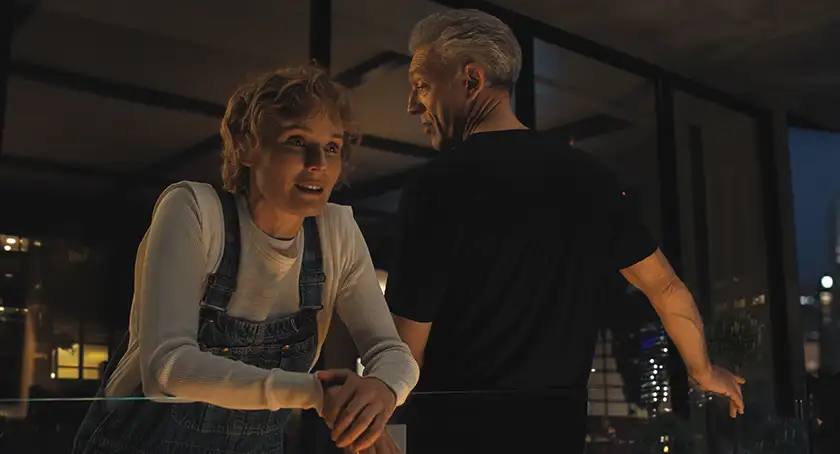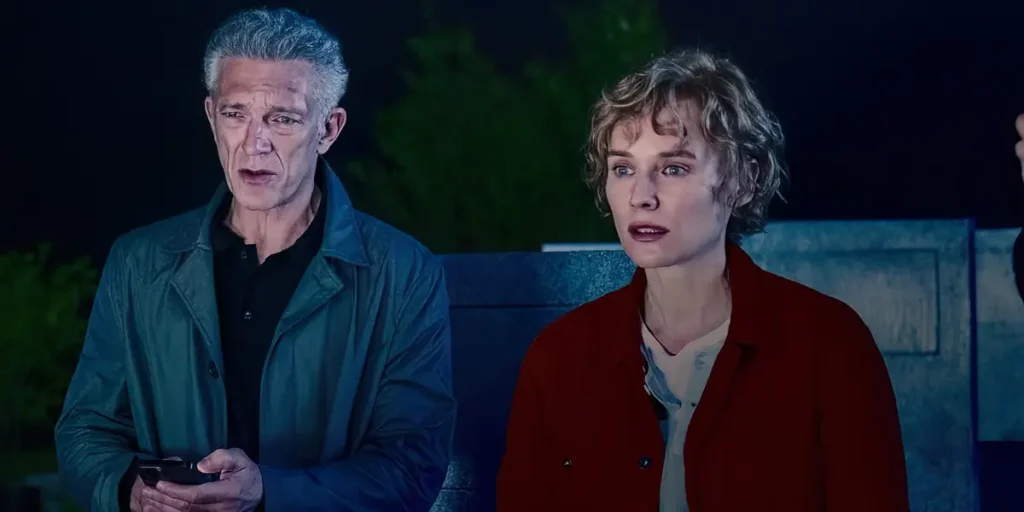With the mesmerising The Shrouds, David Cronenberg explores death with openness and an awareness of his own identity and mortality.
The Shrouds is David Cronenberg’s 21st feature as director. Many of his previous 20 films have been hailed as masterworks because of his confidence in melding thematic weight with memorable grue. However, for all the morbid mayhem he has conjured, Cronenberg has scarcely probed the phenomenon of death itself. As we all age, we find ourselves confronted by our beliefs and our mortality, and try to reconcile the two. The Shrouds shows that Cronenberg is no different.
In March this year, the inaugural London Soundtrack Festival welcomed Cronenberg and his regular musical collaborator Howard Shore as guests. They presented screenings of Crash and Dead Ringers in IMAX, and Shore received the festival’s Inspiration Award. As much as these events celebrated their work together over several decades, there was something poignant in seeing them arrive at the IMAX screenings. Shuffling out under the massive screen, both had visibly aged, with Cronenberg’s angular features accentuated by a raft of wrinkles, and Shore using a walking stick to steady his movement. Progression into old age won’t be a surprise to either man; Cronenberg’s career has been defined by exploring the fragility of the human body, and The Shrouds continues in that vein by exploring its fragility post-mortem.
Death in Cronenberg’s films before The Shrouds
David Cronenberg has always enjoyed a reputation as the thinking man’s horror auteur, with human flesh as the main casualty at the intersection between sex, technology and violence. However, one phenomenon that is relatively unexplored in Cronenberg’s oeuvre is the means by which so many of his characters achieve their goals, namely death. On the surface, it seems unusual to claim Cronenberg’s work isn’t interested in death. Given how often (and how memorably) characters die in his films, it is a primary concern for the director.
However, death is usually just a barrier to be crossed for Cronenberg’s characters. They often come into close contact with their own mortality, but only on their way to another destination, usually some form of physical or sexual transcendence, or a re-establishing of control. The dead in Crash and Rabid are mere collateral damage in the leads’ need to climax, while the medical misadventures of Dead Ringers and Crimes of the Future come from the characters’ need to subjugate their flesh in extreme circumstances. The fact they could die is subordinate to the need to take action against bodies that aren’t conforming to their owners’ wants.
Part of the appeal of Cronenberg’s films is that they can function with minimal context. For example, The Fly works as a terrifying horror and a doomed love story before reading parallels into the AIDS crisis or general fears around terminal illness. Any subtext can only enrich a given film, but Cronenberg’s distinct brand of onscreen ick can usually stand alone.
Of course, not all his films are horrors, but even his least bloody flicks cleave notably to genre expectations. A History of Violence and Eastern Promises are elevated thrillers with flashes of Cronenbergian bloodletting. A Dangerous Method is a fascinatingly dry exploration of Freud and Jung’s working relationship, but its respectable biopic template means this tale of deconstructed sexuality is never particularly sexual on its own terms (for good or ill, but that absence of palpable sexuality is entirely intentional). These films operate on multiple levels; the surface sheen of genre satisfies, but their metaphorical depths lay waiting to be explored. Even while acknowledging those themes, Cronenberg leaves the choice to take that plunge up to the viewer.
The Shrouds: Cronenberg’s most personal work
The Shrouds is a notable exception. It is a deeply personal work, inspired by the writer-director’s own experiences of grief, religious pondering and bodily collapse. Sooner or later, all our thoughts are bound to turn to death. If we’re not feeling the physical effects of aging, then we’re witnessing loved ones succumb to them. Cronenberg certainly has, and knowing this is key to making The Shrouds work, and he drops many hints throughout the film that it must be engaged with on metaphorical terms. Anyone with any knowledge of Cronenberg will recognise the protagonist Karch (Vincent Cassel) as an avatar of the director. Cassel’s hair is dyed white, and he wears dark clothes and white shoes that match the director’s style.
The Shrouds centres on the depth of Karch’s mourning of his late wife Becca (Diane Kruger), who died from cancer. Cronenberg’s own wife Carolyn passed away in 2017 following a battle with cancer, and while this is not his first film since her death, it is the work of a man grappling with death and its onset in all its forms. The film opens with Karch in the dentist’s chair, where he’s told that his grief is causing his teeth to rot.
Lest this sounds obvious, we later learn that Karch has developed the Shroud, a garment into which a corpse is placed before burial, and which can project images of the decaying corpse to a screen on the deceased’s tombstone, or on to a smartphone app. Get past the invasive ickiness of the idea, and you find a director working against his own desperation. It’s a variation on the story of ‘The Monkey’s Paw’, asking whether reconnecting with the deceased is ever a worthwhile pursuit.

Karch laments his failed attempts at dating again, acknowledging “It’s been decades since I had to seduce a woman.” Seduction is pointless when you’ve only known desire for one body and one person for so long. Audiences might be taken aback that a director in his 80s should be so open about sexuality in a film inspired by his late spouse, but it shouldn’t be a surprise when you remember how personal Cronenberg can get in his films. He has used his work to explore all manner of relationships in the past.
Cronenberg’s characters are usually coming to terms with the truth about a family member. By the director’s own admission, The Brood was written to vent his frustrations after his acrimonious divorce from his first wife. The protagonists of Maps To The Stars and Spider confront the damage wrought upon them by their own parents. Cronenberg’s films are about many things, but they are as likely to be about himself as anything else.
Death as Cronenberg’s End Goal in The Shrouds
In the world of The Shrouds, Karch cannot escape the memory of Becca, even if he wanted to. He uses his patented Shroud to view his wife’s now-skeletal corpse, but he also has a living version of her in the form of her twin sister Terry (also played by Kruger). Her presence is the most obvious throwback to Dead Ringers, in which Jeremy Irons plays the sinister but sad Mantle twins. Being an identical twin, Terry offers a vision of Karch’s wife that he cannot love.
One thing that The Shrouds emphasizes is that Karch misses Becca completely. She was everything to him: his romantic ideal, his close companion, his sexual partner. In Dead Ringers, Beverly and Elliot Mantle
are bonded to each other in a similarly all-encompassing way (but mercifully without a sexual element). Neither can define themselves without the other, and their eventual suicide is the only way they could be bonded together permanently. They don’t want to die, but by the end of the film it is clear the pair feel they have no other choice.
Unlike the Mantles, Karch actively seeks death for its own sake. He has no illusions that it is to be avoided. He describes an urge to get into his wife’s coffin at her funeral, and the creation of the Shroud is the closest he comes to making that scenario a reality. The tragedy of Dead Ringers is that the Mantle twins feel the need to die to be complete, but the film doesn’t promise that their deaths will fulfill that need. In The Shrouds, Cronenberg is careful to show that Karch isn’t exactly suicidal.
Karch desires a reunion with his wife beyond the limits of physical experience via his new technology, but is not trying to take his own life. This harkens back to Cronenberg’s best known onscreen dalliances with the merging of man and machine. From the intersection of bodies and games consoles in eXistenZ to the vision of James Woods climbing into the waiting lips of Debbie Harry via his TV in Videodrome, Cronenberg has always cautioned against using technology to satisfy our needs/wants. However, in those films, the needs being satisfied were sexual or creative in nature (despite the terrifying outcomes). In The Shrouds, a taste of death itself is the end goal.

Religion and Death in The Shrouds
The Shrouds’ relationship to death is particularly interesting in the context of its religiosity. Cronenberg is an atheist, but has been reticent to define himself as such. He was raised in a secular Jewish family, and this part of his identity is very much at the forefront of The Shrouds. Karch and Becca are Jewish, and her tombstone features a Star of David. He lingers on this marker most notably when, in a mid-film plot development, Karch’s cemetery for users of his Shrouds is vandalized. He finds Becca’s tombstone torn down, and the camera inspects the damage, gliding over the Star surrounded by cracks in the stone.
The film is being released in the context of the Israel-Gaza conflict. Criticism of the ongoing Israeli offensive and the resulting bloodshed have led to an uptick in antisemitic sentiment, and it forces a secular Jew like Cronenberg to acknowledge how that identity informs his worldview. In Jewish belief, the decay of the body liberates the soul to the afterlife. In The Shrouds, he tries to reconcile his materialist worldview to the traditions that were passed on from previous generations. How can he wish to liberate a soul he doesn’t believe in? In both the material and religious view, death is a natural occurrence, a relinquishing of corporeal woes. The only way to explore how these competing worldviews on death can be reconciled is to get as close to it as possible.
Death: In cinemas now!
The Shrouds fits into a larger trend of films and filmmakers seeking closer brushes with death, and the recontextualisation they can bring. The Shrouds was screened in competition at the 2024 Cannes Film Festival, where other films touched on similar ideas. Oh, Canada was Paul Schrader’s portrait of a man wishing for death to put an end to his own shame, and The Substance saw Demi Moore literally tear herself apart to be reborn in a younger body. This year’s festival featured a number of films centred on characters staring down their own mortality (The Phoenician Scheme, Sirât, Alpha). Meanwhile, blockbusters like 28 Years Later and Final Destination: Bloodlines see their leads forced to reframe their relationships with death, and coming to terms with it as a necessity rather than something to be feared.
These aims may be reflective of an increasingly despairing world, but they have to come from a profoundly personal place. After all, death is a journey we all take alone. The Shrouds sees a filmmaker confronting that journey by plotting his path along the one his loved ones have taken to get there.
The Shrouds was released in US theaters on April 25, 2025 and in UK & Irish cinemas on July 4. The film is now available to stream on digital & VOD in the U.S. and more countries and will be released on digital platforms in the U.K. and Ireland on August 11, 2025. Read our review of The Shrouds!

